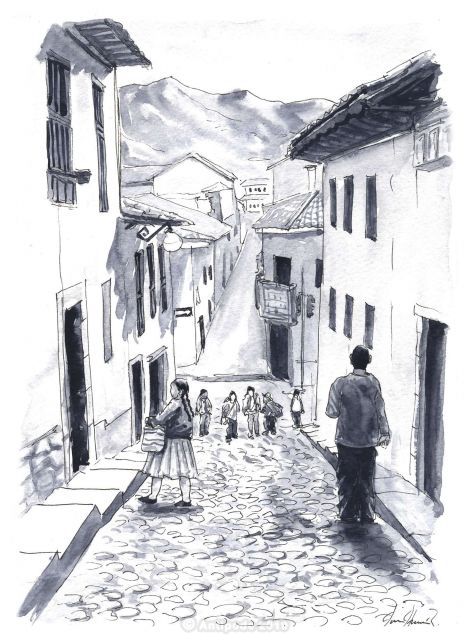

What are the historical origins of the city of Cusco in Peru?
History of Cusco: Here more than elsewhere, the Peruvian syncretism takes all its extent. Beating heart of the Inca empire 500 years ago, it is also a major center of the sacred art, with the school cusquenian, Christian, ... therefore Spanish! The buildings themselves are an intrinsic mixture of the two heritages, the artistic representations mix the chicha and the cuy in the Last Scene... The history of the city of Cusco is extremely rich, and sums up by itself the various stages of the evolution of Peru.
The foundation of the city is the subject of two legends, one that of Manco Inca and his wife Mama Ocllo, who came out of the waters of Lake Titicaca and were sent by the god Viracocha to find the land in which the golden scepter would be buried, the one that would see the heart of a great and powerful civilization expand. The name "Cusco" comes from the Quechua "Qosqo", which means "navel of the world". For the Incas, this city was neither more nor less than the center of the Universe. After a slow and uneven development during centuries, the Inca Pachacutec begins in 1438 intense urban reforms: from a small provincial town made of straw and dried mud, it transforms Cusco into a dynamic city of first importance, the proud capital of an empire covering half of the South American continent. First of all, he reorganized the urbanization plans of the city: he rebuilt it in the shape of a puma, this sacred animal of the Andean religion, the head being the citadel of Sacshayhuaman and the body, the main square of Haucaypata. Then, he developed agriculture in the surroundings close to the city, thanks to the construction of many aqueducts and agricultural terraces, such as the site of Tipon or Moray. Finally, with the administrative organization of the empire, Pachacutec unifies the different versions of the Andean culture and religion, imposes the Quechua of Cusco to all the annexed territories and the Inca religion is imposed and mixed with the local traditions. And it makes of Cusco a major spiritual city: the 15 000 inhabitants of the city are in great majority nobles, priests and servants. Ceremonies and rituals are the object of incessant pilgrimages from the four corners of the kingdom. Cusco has become THE political, administrative and cultural center, and the central axis directing the religious life of the continent.
70 years is the time during which Cusco could taste the glory. The influence of the most important city of South America was cut off by the arrival of the Spaniards, the desecration and the plundering of these invaders with their strange skin. All the efforts of destruction and annihilation were concentrated in Cusco, because they knew that the symbol of their triumph would be the capture of the imperial city. The shock is intense for this civilization that seemed to be only at the beginning of its expansion and glory.
For a long time, under the Spanish domination, Cusco remained an important place. For the Spaniards, it is there that it is necessary to impose the hardest the new colonial rules and to print the most strongly the Christian religion: it is necessary to transmit the image of the new domination on the highest center of the Inca civilization (from where the construction of the church of Santo Domingo on the Qoricancha, or the cathedral on the palace of the Inca). Symbolically, it is necessary to convert the heart of the empire to have the whole empire at its feet. On the other hand, for the natives, it is the catalyst place of the claims: the claim that has most marked the colonial history is that of Tupac Amaru II in 1781. These months of struggle were contagious in the provinces, and the colonial order was truly shaken; hence the unparalleled cruelty of the repression. Moreover, Cusco maintained at that time a crucial role as a commercial crossroads, between Lima (the only official port from South America to Europe) and the silver mines of Potosi.
But with the Inca empire finally conquered, the development of the new capital on the coast and the obnubilation of the conquerors by the wealth of the Cerro Rico of Potosi, Cusco inevitably falls into oblivion. It becomes a provincial city like any other, and sees itself competing with the economic development of younger cities like Arequipa or Iquitos. It will leave its torpor only with the "rediscovery" of Machu Picchu in 1911 by Hiram Bingham (and the publication of his book "The Lost City of the Incas"). At the end of the XX° century, the Peruvian State and the region of Cusco invest gigantic sums in the tourist infrastructures, and little by little the streams of tourists invade the streets of stones paved with balconies of carved wood, marvel in front of the Inca remains and give a reason to be proud again to the city and its inhabitants after decades of a traumatic history.
Also noteworthy are the numerous earthquakes that destroyed the colonial buildings but spared the Inca foundations: revenge of the gods or simply a more adapted architectural technique? In any case, the result is the image of the Señor de los Temblores, protector of Cusco and his exceptional heritage.



